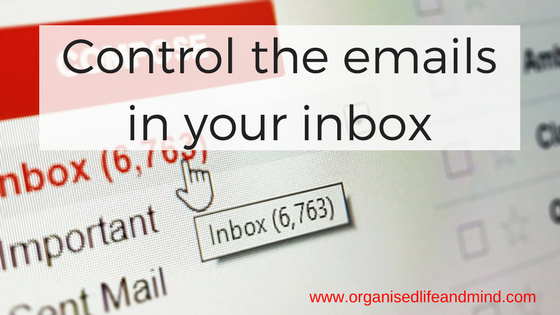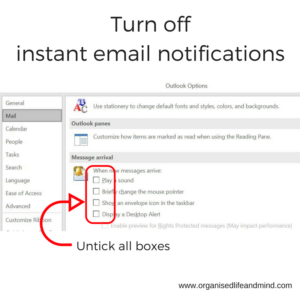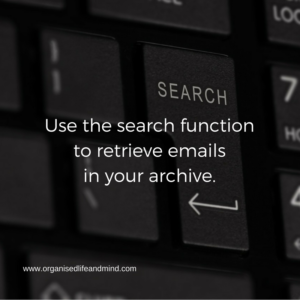How to become the master of your inbox again
Over the last months, we’ve been working with a corporate client. It’s so different from residential organising and yet there are so many similarities. Everyone wants to be more organised. Everyone wants to use their time better. Everyone wants to find what they are looking for when they need it. This isn’t surprising, is it?
For our corporate clients, the focus is often more electronic documents and files. This makes it for most individuals more challenging. Out of sight, out of mind. Still, the desire to declutter that overflowing inbox is just as great as of the fashionista client who wants to see what’s in her wardrobe. Today, we’re sharing our tricks to control the emails in your inbox.
Turn off instant notifications
One of the biggest distractions are instant notifications. Whether it’s that beep sound on your phone, the little red light on a Blackberry or the desktop alert from your inbox, they all interrupt your flow. Now, it may only be a second but it’s a disturbance. How often have you glanced at that email notification, seen who the sender or what the topic was and got upset by it? It generally takes 2 minutes to get back into the topic you’ve been working on before you briefly checked that notification!
You can turn off the desktop alert from your Outlook inbox by going into Options/Mail/Message Arrival and deactivate all boxes.
Check at specific times
You may want to check your emails all the time. Living in a region where we are constantly connected, it can be tough to not be online all the time. Still, we recommend you check your emails at specific times only. “There’s no way I can do that. My clients need me immediately!”
Start small. Check your emails only every 5 minutes. This gives you some time to work on a quick task. As you feel more comfortable, you can expand this time frame to 15 minutes or more. A lot of our clients are anxious not seeing their new emails immediately and don’t like to be away from their inbox for a long time. They do, however, notice after 2-3 days how much productive they are and are at ease to only checking their emails 4x in an hour (yes, that’s every 15 minutes).
As everyone is different, we even had some clients who were happy to expand their email checks and only looked in their inbox after they finished a task. This could have been after 20 minutes or 45 minutes.
The 2-minute rule
David Allen, the author of Getting Things Done, came up with this rule. If you can handle an activity within 2 minutes, do it now. Otherwise, block some time and do it later.
File immediately
Once you’ve read an email and no action was required, file it. Once you’ve replied to an email, archive it. Your inbox should only have emails which require some action.
We’ve seen many individuals who have created subfolders for their emails. You can move your emails directly into your archive and search for it when you need it. “But I won’t be able to find it!” The search functions have improved tremendously that there’s no need for subfolders anymore. It lets you search by sender, time frame, size, attachment, etc.
Use out of office replies
We’ve worked with a boss in a previous life who loved this. Whenever he needed to focus for a big project, he let other folks in the organisation know that he wasn’t available through his out of office. While some people did not appreciate it at first, it helped to manage expectations and gave him the time to concentrate. It also reduced the number of emails he’d receive during these times as colleagues would go to the appropriate point of contact from the start! “This will never work in my role!” Give it a try and you may also be surprised how many others start this practice.
Start from scratch
Is your inbox overfilling with thousands of unread emails? There’s no chance you can ever get enough time to read and action them? This is an extreme proposal: Archive (delete) them all and start new. If someone wants something from you, they can resend the original email. Would you dare this?
Whether you are an individual or a manager wanting to be more effective with your emails, implementing these tips is a first step to controlling your inbox. Equally important is being consistent in managing your inbox in the future. If you want to learn how we can help you (and your team), contact us today!
Until next time,
Agni



